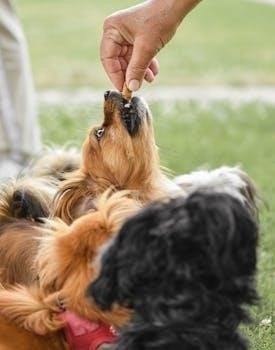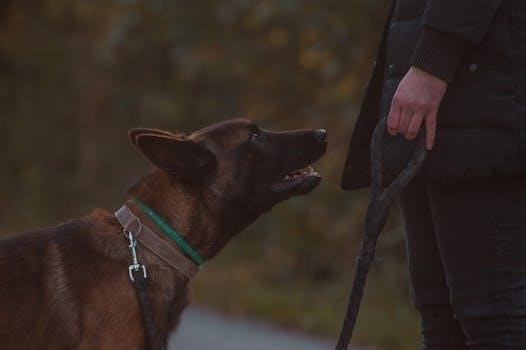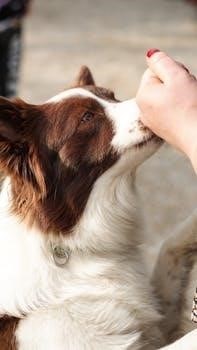Dog training hand signals are a crucial method for effective communication. They utilize visual cues, which dogs often grasp more readily than verbal commands. These signals can greatly enhance a dog’s understanding and response during training sessions, offering an alternative to spoken instructions.
The Importance of Visual Cues in Dog Training
Dogs are highly attuned to body language, making visual cues a powerful tool in training. Unlike humans, who rely heavily on spoken words, dogs often process non-verbal communication more efficiently. Using hand signals taps into this natural ability, allowing for clearer and more direct instructions. Visual cues bypass the complexities of language, providing immediate and unambiguous communication. This is particularly beneficial when teaching new commands. Furthermore, visual signals can be consistently delivered regardless of environmental noise or the trainer’s vocal tone, ensuring the dog receives clear instructions every time. This consistency leads to faster learning and stronger associations between actions and commands. Therefore, incorporating hand signals optimizes the training process by leveraging dogs’ natural strengths in interpreting visual information, fostering a deeper understanding and bond between dog and owner.

Benefits of Using Hand Signals
Hand signals enhance communication, especially in noisy areas. They offer increased control, and are useful for deaf or aging dogs. These visual cues improve training effectiveness overall.
Enhanced Communication and Control
Utilizing hand signals in dog training significantly improves the clarity of communication between you and your canine companion. Dogs are naturally adept at interpreting body language, often responding more effectively to visual cues than to spoken words alone. This enhanced understanding allows for a smoother training process, leading to quicker and more reliable responses from your dog. Furthermore, hand signals provide a subtle method of control, especially in situations where verbal commands might be impractical or ineffective. They allow you to guide your dog with precision, creating a stronger bond based on mutual understanding, fostering a more harmonious and effective training experience. This form of communication also helps maintain focus and attention during training, making your sessions more productive and engaging for both you and your dog, strengthening the link between you.
Improved Training in Noisy Environments
One of the significant advantages of using hand signals in dog training is their effectiveness in noisy or distracting environments. Unlike verbal commands, which can be easily drowned out by background sounds, hand signals provide a clear and consistent visual cue that your dog can readily perceive. This is particularly beneficial in outdoor settings, at dog parks, or during events with a lot of ambient noise. By relying on hand signals, you can maintain control and communicate effectively with your dog regardless of the surrounding distractions. This ensures that your training remains consistent and productive, allowing your dog to focus on your instructions without being hindered by the external noise. This enhanced focus leads to better learning and strengthens the bond between you and your pet in any environment. The use of hand signals will allow you to train effectively no matter the surrounding chaos.
Assistance for Deaf or Aging Dogs
Hand signals become indispensable when training deaf or aging dogs, who may have diminished hearing capabilities. For deaf dogs, visual cues are essential for communication and training, as they cannot rely on verbal commands. Similarly, as dogs age, they often experience a decline in their hearing, making it difficult for them to respond to spoken words. Hand signals provide a reliable way to communicate effectively with these dogs, ensuring that they can understand and follow your instructions. This method of training allows them to continue learning and participating in activities, maintaining their mental engagement and overall quality of life. By utilizing hand signals, you can bridge the communication gap, fostering a stronger bond and a more rewarding training experience for both you and your aging or deaf companion. The visual cues are their way to understand what you want them to do.

Common Hand Signals for Dog Training
Various hand signals are used in dog training, each corresponding to specific commands. These include signals for sit, stay, come, down, and go. Using consistent hand signals aids clear communication with your dog.
Sit⁚ Upward Facing Palm
The hand signal for “sit” is typically an upward-facing palm. To execute this signal, start with your hand near your waist and then raise it to shoulder height, keeping the palm open and facing upwards. Extend your fingers forward as you make the motion, positioning your hand in front of the dog’s nose. This movement acts as a visual cue, encouraging the dog to lower its hindquarters and assume a sitting position. It is a very common and easily recognizable signal that many dogs can learn quickly, especially with consistent training and positive reinforcement. Make sure that your hand is always facing upwards to avoid any confusion for the animal. This gesture is a clear and concise way to communicate this basic command, and is widely used by trainers and pet owners.
Stay⁚ Palm Facing Out
The “stay” command is usually represented by a hand signal where your palm is facing directly outward, towards the dog. This is a clear visual cue that signals the dog to remain in its current position, whether sitting, standing, or lying down; The gesture is performed by extending your arm out in front of you with your palm open and facing forward. It is important to maintain eye contact with your dog while giving this signal to reinforce its meaning. The key is to keep your hand still and not make any sudden movements. This signal is used to indicate that the dog should remain in place until given another command and is very helpful in many situations. Consistency in this signal will help your dog learn it very quickly.
Come⁚ Closed Fist
The “come” command is often signaled using a closed fist. This visual cue is typically combined with a pulling motion, as if you are reeling the dog towards you. The hand starts with an open palm and then closes into a fist as you draw your arm in towards your body. This action encourages the dog to move in your direction, reinforcing the concept of coming when called. This hand signal is used to encourage the dog to approach and is a fundamental element of recall training. It is essential to use positive reinforcement when the dog comes to you to make the experience rewarding. The closed fist signal is distinct and easy for dogs to recognize.
Down⁚ Flat Hand
The “down” command is frequently taught using a flat hand signal. This involves extending your arm with your palm facing downwards, and gently lowering it towards the ground. This signal mimics the action of lowering the dog’s body to the floor. The flat hand is a clear visual cue that is easy for dogs to understand, making it an effective tool in training. The hand movement should be smooth and consistent each time, which helps the dog to associate the hand signal with the desired behavior. It is also possible to combine this hand signal with a verbal command. Consistency in training is essential for the dog to quickly grasp the meaning of the flat hand signal for the “down” command.
Go⁚ Pointing Forward
The “go” command is often associated with a hand signal where you extend your arm and point your index finger forward, indicating the direction you wish your dog to move. This gesture is a clear and intuitive visual cue, making it easy for dogs to understand the intended action. This forward-pointing signal can be used to direct your dog to move ahead of you, go to a specific spot, or proceed through a doorway. The consistency of this hand signal will help your dog quickly recognize and respond to the command. It is also beneficial to use a verbal cue along with the hand signal during training sessions. The combination of both cues will help the dog to associate the signal with the desired outcome more effectively.

How to Teach Hand Signals
Teaching hand signals involves a patient approach that combines visual cues with positive reinforcement. Lure-and-reward methods are very effective, using treats to guide dogs into desired positions while using the corresponding hand signal.
Lure and Reward Training
Lure and reward training is a highly effective method for introducing hand signals to your dog, making the learning process both engaging and positive. This technique involves using a treat or a favorite toy to guide your dog into the desired position that corresponds to a specific hand signal. For instance, when teaching the “sit” command, you would hold a treat near your dog’s nose and slowly move it upwards, which naturally encourages them to lower their hindquarters into a sitting position, while simultaneously using the upward-facing palm signal. As your dog starts to understand the association between the hand signal and the action, the lure can gradually be phased out. This method allows for clear communication and positive associations, making the training process more enjoyable and effective for both you and your canine companion. Consistent, short training sessions are ideal.
Consistency and Positive Reinforcement
Consistency is paramount when teaching hand signals, ensuring your dog clearly understands each visual cue. It’s crucial that all members of your household use the same hand signals for each command, avoiding confusion and reinforcing learning. Positive reinforcement plays a key role, rewarding your dog with praise, treats, or toys immediately after they correctly perform the action associated with a hand signal. This positive feedback creates a strong link between the signal and the desired behavior, encouraging your dog to repeat the action. Avoid negative corrections, as they can hinder progress and create anxiety. Short, frequent training sessions are more effective than longer, less frequent ones. Patience is also vital, and celebrating small successes makes the learning process fun and rewarding.

Printable Dog Training Hand Signals Chart PDF
A printable dog training hand signals chart in PDF format is a valuable resource. These charts are readily available online, offering a visual guide for consistent training.
Availability of Charts from AKC and Other Resources
Numerous resources provide printable dog training hand signal charts, including the American Kennel Club (AKC). These charts are often available in PDF format, making them easily accessible for download and printing. The AKC and other reputable organizations create these charts to assist dog owners in implementing effective training methods. Many websites dedicated to dog training also offer free printable charts as part of their educational materials. These resources often feature clear illustrations and concise instructions, ensuring users can quickly understand and apply the hand signals. Furthermore, various dog training forums and communities share downloadable charts, allowing for a wide range of options. These charts are designed to accommodate different training styles and needs, making them a valuable tool for dog owners at all levels of experience. They provide a reliable reference for both beginners and experienced trainers alike, ensuring consistent and accurate communication with their canine companions.
Using Charts for Wall Display and Reference
Printable dog training hand signal charts are invaluable tools when used for wall display and reference. Affixing a chart to a wall in a training area provides a quick visual guide for all members involved in the training process, ensuring consistency in the signals used. This method proves particularly beneficial in households where multiple individuals handle the dog’s training. Having the chart readily visible helps trainers recall the correct hand signal, reducing confusion for the dog and promoting effective learning. Furthermore, these charts act as a constant reminder of the proper techniques and cues, reinforcing their importance. The charts can also be used as a reference during training sessions when a quick reminder is needed. By having these charts prominently displayed, it enhances the learning experience, making training sessions smoother and more productive. This visual aid ensures every command is clear and correctly executed, contributing to a well-trained and obedient dog.


